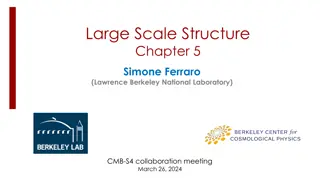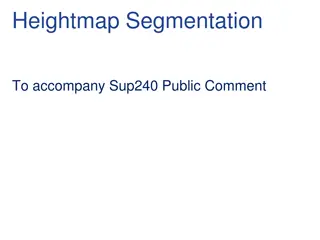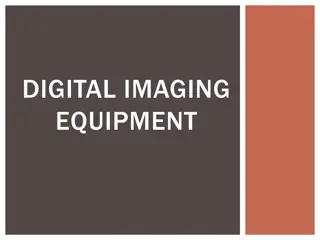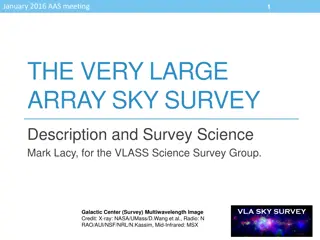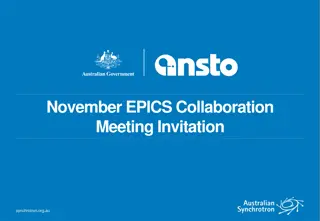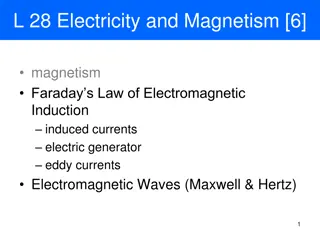Neural quantum state tomography, improvements and applications
Advancements and potential applications of neural quantum state tomography, aiming to reduce the exponential classical memory required for expressing quantum states. It discusses the benefits of using machine learning techniques to process and analyze quantum data, such as cleaning up states, manipu
4 views • 26 slides
OCTIVUS Randomized Clinical Trial: OCT-Guided vs IVUS-Guided PCI
The OCTIVUS Randomized Clinical Trial compared the clinical efficacy and safety of Optical Coherence Tomography (OCT)-guided and Intravascular Ultrasound (IVUS)-guided strategies in patients undergoing PCI for significant CAD. The study aimed to determine if OCT-guided PCI is noninferior to IVUS-gui
8 views • 27 slides
Radar Attenuation Tomography for Mapping Englacial Temperature Distributions
Radar Attenuation Tomography is used to map the temperature distributions within the ice sheet by analyzing the radio waves' attenuation properties. This study focuses on the Eastern Shear Margin of Thwaites Glacier, where fast-moving ice meets slower ice, impacting ice rheology influenced by temper
4 views • 18 slides
Role of High-Resolution Computed Tomography in Fibrosing Interstitial Lung Diseases
HRCT plays a crucial role in diagnosing and monitoring fibrosing interstitial lung diseases (ILDs). It helps identify abnormalities not visible on X-rays, leading to early, accurate diagnoses and potentially avoiding invasive procedures. HRCT assists in distinguishing specific ILDs based on radiogra
1 views • 25 slides
Radiographic Imaging Methods of the Respiratory System
Radiographic imaging plays a crucial role in the evaluation and diagnosis of thoraco-mediastino-pleuro-pulmonary conditions. Techniques like radioscopy, digital radiography, computer tomography, magnetic resonance imaging, conventional pulmonary angiography, and hybrid imaging methods offer detailed
10 views • 21 slides
Large Scale Structure Chapter 5
Simone Ferraro from Lawrence Berkeley National Laboratory discusses the significance of Cosmic Microwave Background (CMB) experiments in probing the large-scale structure of the universe. Covering topics like the interaction of photons with matter, CMB lensing, and CMB lensing tomography, this prese
3 views • 21 slides
Procedure for Quantifying Interlaminar Damage in Refractory Composites Using Micro-X-Ray CT
This study presents a method to quantify interlaminar damage in refractory composites through in-situ micro-X-ray computed tomography. The procedure aims to capture the progressive failure in ASTM-sized specimens, providing empirical data for improving simulations of composite materials. Various spe
6 views • 19 slides
SALIVARY GLAND IMAGING
Salivary gland imaging plays a crucial role in diagnosing and monitoring diseases of the major salivary glands, including the parotid, submandibular, and sublingual glands. Different imaging techniques such as computed tomography, MRI, and ultrasound are used to visualize these glands and aid in dif
1 views • 12 slides
Unveiling the Insights of the Computed Tomography Market Globally | BIS Research
According to BIS Research, the Global Computed Tomography Market is projected to reach $10.21 billion by 2033 from $6.17 billion in 2023, growing at a CAGR of 5.22% during the forecast period 2024-2033.
2 views • 3 slides
Understanding Heightmap Segmentation in DICOM Imaging
Exploring the use of heightmaps in DICOM imaging for surface identification in 3D volumes and retinal layer surfaces in ophthalmic tomography. Learn about segmentation tasks, binary segmentation results, and the role of heightmaps in classifying anatomical features in medical images. Discover how se
1 views • 28 slides
Advanced Imaging Technologies in Healthcare
Explore the world of digital imaging equipment including computed tomography (CT) scanners and magnetic resonance imaging (MRI) machines. Discover how these technologies work, their uses in medical diagnosis, and important facts to consider. Learn about the risks associated with CT scans and the ben
0 views • 59 slides
Understanding AC Power Generation and Faraday's Law in Electrical Engineering
This course introduces students to AC power generation in electrical engineering. Concepts such as magnetic flux, induction of EMF through Faraday's Law, and examples like hydroelectric turbines and gasoline motors are covered. The course aims to provide a comprehensive understanding of how electric
1 views • 40 slides
Understanding Magnetic Moments and Susceptibilities in Materials
Determination of magnetic moment and susceptibility plays a crucial role in studying the magnetic properties of materials. This involves methods like Guoy balance for paramagnetic substances and observing weight changes for diamagnetic substances. The Faraday method, employing a quartz container in
0 views • 20 slides
Understanding the Derivation of the Nernst Equation and Its Implications
The Nernst Equation is derived to provide insight into membrane potential and its role in various health conditions like cystic fibrosis and epilepsy. This derivation involves combining diffusive flux, electric drift, and mobility terms, leading to a deeper understanding of membrane behavior. The Bo
1 views • 26 slides
Understanding Inductance in Electrical Circuits
Inductance in electrical circuits is a crucial concept defined by Faraday's law. It measures the opposition to changes in current, with inductors storing energy in their magnetic field. Mutual inductance and LC circuits further showcase the interconnectedness of inductance in electronic systems.
2 views • 8 slides
Understanding Electrode Reactions in Electrochemistry
Exploring electrode reactions in electrochemistry involves delving into Faraday's law, coulometry, and the importance of sustainable electrode reactions. These concepts help us understand how the quantity of charge passed affects the production or consumption of substances in electrode reactions. As
4 views • 27 slides
Understanding Corrosion and Electroplating in Chemistry
Delve into the fascinating world of corrosion and electroplating with a detailed exploration of their principles, processes, and methods of protection. Learn about atmospheric corrosion, immersed corrosion, chemical corrosion, underwater corrosion, and underground corrosion. Discover the electrochem
2 views • 36 slides
Positron Emission Tomography: Applications in Society and Recent Developments
Positron Emission Tomography (PET) is a medical imaging technique focusing on metabolic differences in the body. By using positron-emitting radioisotopes, PET can detect how molecules are taken up by healthy and cancerous cells, aiding in accurate tumor localization with lower doses. The evolution o
0 views • 6 slides
Value Optimization Through Diamond Tomography: Executed Solutions and Alternate Plans
This presentation explores the process of optimizing value through diamond tomography, showcasing rough diamond samples, executed solutions, and alternate plans. Detailed analysis of diamond characteristics and gains achieved, along with visual representations of proposed strategies and implemented
0 views • 6 slides
Understanding the VLA Sky Survey and Its Scientific Goals
The VLA Sky Survey (VLASS) is a comprehensive radio survey covering the sky visible to the VLA, conducted in three epochs with a focus on imaging galaxies, detecting transient events, exploring Faraday tomography, and uncovering hidden phenomena in the universe. The survey employs innovative strateg
1 views • 22 slides
VLASS Sky Survey and Galactic Science Highlights
The January 2016 AAS meeting discussed the VLASS Sky Survey, highlighting survey parameters, science drivers, and the potential for new discoveries in galactic science. Key topics included multiwavelength imaging, Faraday tomography, AGN and galaxy evolution studies, and the search for exotic system
2 views • 9 slides
Understanding Nucleon Structure: Insights from EIC Workshop
Exploring the mechanics of nucleons and the physics goals of the Electron-Ion Collider (EIC), this content delves into the origin of nucleon mass and spin, emergent properties of dense gluon systems, and energy-momentum tensor in QCD. It discusses the role of gluons in understanding nucleon structur
0 views • 31 slides
Applications of Radioisotopes in Nuclear Medicine
Nuclear medicine utilizes radioisotopes to provide crucial diagnostic information about the functioning of specific organs and to treat various conditions. Diagnostic techniques in nuclear medicine involve using radioactive tracers that emit gamma rays from within the body. Positron Emission Tomogra
0 views • 19 slides
Enhancing the Synergy Between Astroparticle Physics and Geoscience: APPEC-GEO8 Workshop Insights
The workshop discussion highlighted the growing synergy between Astroparticle Physics and Geoscience, emphasizing the importance of precise understanding of the Geosphere for studying the Cosmos. Topics included Neutrino tomography, deep life exploration, optical fibers coupled with sensors, seismic
1 views • 4 slides
Understanding Impedance and Phasor Diagrams in AC Circuits
Resistive elements in AC circuits exhibit zero phase shift between current and voltage due to their angles. Inductors introduce inductance when connected to AC sources, generating magnetic flux that affects conductor charges. Faraday and Lenz's laws explain induced voltage and current direction base
0 views • 18 slides
EPICS Collaboration Meeting at Australian Synchrotron
Explore the upcoming EPICS Collaboration Meeting at the Australian Synchrotron in Melbourne, Australia from 12-16 November 2018. Learn about the advanced third-generation 3.5 GeV light source, exciting beam lines, and upcoming projects like Micro-Computed Tomography and X-ray Absorption Spectroscopy
1 views • 4 slides
Understanding Magnetism: Faraday's Law and Induction
Explore the fundamental concepts of magnetism, including Oersted's and Ampere's discoveries, Faraday's Law of Electromagnetic Induction, and the generation of induced currents. Delve into the interplay between magnetic fields and currents as elucidated by Michael Faraday, and learn how changing magn
0 views • 24 slides
Advanced Virgo Squeezing Working Group Overview
The Advanced Virgo (AdV) project involves various activities related to squeezing technology, optical layouts, Faraday isolators, and electronics. The project includes components like the squeezer, clean room, detectors, telescopes, and alignment systems. The installation, commissioning, and status
0 views • 34 slides
Understanding E and B Fields in Physics 213
Explore concepts such as light polarization angles, resonance frequency of LRC circuits, Lorentz Force Law, Gauss Law, Faraday's Law, and Ampere-Maxwell Law in Physics 213. Delve into the interplay between electric and magnetic fields, and their effects on charged particles such as electrons and pro
0 views • 19 slides
GNSS Ionospheric Study in Korea: Insights and Findings
Explore the status of GNSS ionospheric study in Korea, including details on Korea's GPS permanent network, IGS, KASI Global Data Center, TEC mapping, and ionospheric tomography. Discover how ground-based GPS data is used to study ionospheric electron densities and monitor ionospheric storms in Korea
0 views • 15 slides
Symposium on Positron Emission Tomography and Boron Neutron Capture Therapy Time-Over-Threshold Calibration in J-PET
The 3rd Symposium on Positron Emission Tomography and 1st Symposium on Boron Neutron Capture Therapy focused on Time-Over-Threshold calibration within the framework of J-PET. The event outlined experimental details, event selection, results, and key features of the Jagiellonian Positron Emission Tom
0 views • 35 slides
Assessment of Schlemm's Canal in Acute Primary Angle Closure: AS-OCT Study
Study conducted by Tarannum Mansoori and team aimed to evaluate Schlemm's canal (SC) dimensions in acute primary angle closure (APAC) using anterior segment optical coherence tomography (AS-OCT). Their findings indicate changes in SC parameters post-treatment, emphasizing the importance of SC in mai
0 views • 6 slides
Understanding Faraday's Law of Induction and Lenz's Law
Faraday's Law of Induction states that a changing magnetic field induces an electromotive force (emf) in a conductor, producing an induced current. Lenz's Law complements this by determining the direction of the induced current to oppose the change in magnetic field. This phenomenon is demonstrated
0 views • 23 slides
Understanding Magnetism: Faraday's Law and Electromagnetic Induction
Explore the fascinating world of magnetism and electromagnetism with insights into Faraday's Law of Electromagnetic Induction, induced currents, and the basic principles of magnetism. Discover how a changing magnetic field can produce a current and unravel the key concepts behind electromagnetic wav
0 views • 24 slides
Understanding Magnetic Flux and Induction Principles
Exploring the concepts of magnetic flux and electromagnetic induction through visual aids and explanations. Topics include the generation of current in coils, Faraday's law, Lentz's law, and the behavior of induced current with changing flux.
0 views • 36 slides
Understanding Faraday's Law of Induction and Electromagnets
Explore Faraday's Law of Induction, magnetic permeability, and the role of soft iron in strengthening magnetic fields. Learn about Faraday's idea of generating current from a magnetic field and his groundbreaking discovery of electromagnetic induction.
0 views • 25 slides
Development of Proton Computed Tomography Apparatus by INFN (RDH-WP3)
The Proton Computed Tomography Apparatus, developed by the INFN (RDH-WP3) collaboration, consists of two pCT systems for high-energy tomography. Various tests and analyses have been conducted, with plans for further testing in 2016. The system utilizes Algebraic Reconstruction Techniques and silicon
0 views • 36 slides
Understanding Dose Efficiency in Computed Tomography Imaging
The physicist conducted testing on a computed tomography scanner to analyze the tube output and dose efficiency at various mAs settings. The shift in dose efficiency between 500 and 600 mAs is due to the use of different focal spots and collimator adjustments. When the collimator accommodates the la
0 views • 6 slides
Computed Tomography Market Demand, Outlook and Forecast 2024-2033 | BIS Research
The global computed tomography market is projected to reach $10.21 billion by 2033 from $6.17 billion in 2023, growing at a CAGR of 5.22% during the forecast period 2024-2033.\n\nRead Report Overview: \/\/bisresearch.com\/industry-report\/computed-to
1 views • 3 slides
Understanding Electromagnetic Testing (ET) in NDT
Electromagnetic Testing (ET) is a crucial NDT method involving techniques like Eddy Current Testing (ECT) and Alternating Current Field Measurement (ACFM). It is used for crack detection, material thickness measurement, and more in various industries due to its sensitivity and immediate results. Des
0 views • 21 slides





